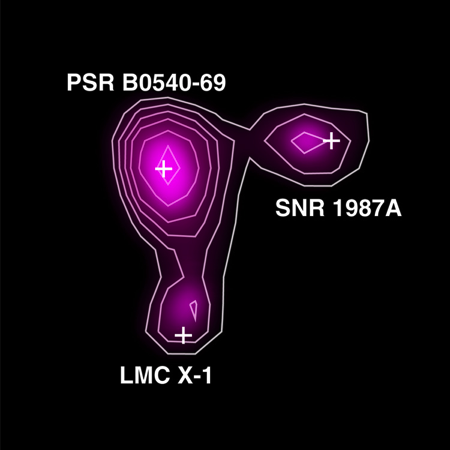44-Ti line emission from young supernova remnants
Only a few radioactive nuclei are accessible to gamma-ray astronomy. Among them, 44Ti is thought to be exclusively produced in supernova explosions of all types, during the early stages, and emits three lines at 67.9, 78.4 and 1157 keV during its decay 44Ti → 44Sc → 44Ca with a lifetime of ~ 85 yrs. It is therefore a valuable tool for constraining the physical parameters governing the SN explosion and for finding previously unknown young SN remnants in the Galaxy. So far, 44Ti lines have been detected directly in only two SNRs (Cas A and SN 1987A), and indirectly in one other SNR (G1.9+0.3, through the 44Sc X-ray line emission). In order to explain the observed 44Ca solar abundance, the required 44Ti yield, derived from several Galactic chemical evolution models, is incompatible with the non-detection of any young SNR (besides Cas A) in the Galaxy by past and current gamma-ray instruments (HEAO-3, SMM, COMPTEL, INTEGRAL/IBIS).
Required instrument performances:
A FOV as wide as possible will be needed to perform a Galactic Plane Survey. A line sensitivity of 10-6 cm-2 s-1 should reveal a dozen of Galactic SNR and probe 44Ti yields of 10-5 Mסּ in Tycho and Kepler type Ia SNRs, as indirectly measured in G1.9+0.3. A spectral resolution of 0.003 will allow us to measure Doppler velocities of 103 km s-1, lower than shock speeds usually found in very young SNRs (v ~ 6000 km s-1 in Cas A), and hence to constrain the dynamics of 44Ti-emitting regions.
 INTEGRAL detection of 44Ti in the remnant of SN 1987A, in the energy range 65 – 82 keV. The emission of the two other sources, the black hole binary LMC X-1 and the pulsar PSR B0540-69 is of different origin. Credit: ESA/INTEGRAL/IBIS-ISGRI/S. Grebenev et al. |
Required instrument performances:
A FOV as wide as possible will be needed to perform a Galactic Plane Survey. A line sensitivity of 10-6 cm-2 s-1 should reveal a dozen of Galactic SNR and probe 44Ti yields of 10-5 Mסּ in Tycho and Kepler type Ia SNRs, as indirectly measured in G1.9+0.3. A spectral resolution of 0.003 will allow us to measure Doppler velocities of 103 km s-1, lower than shock speeds usually found in very young SNRs (v ~ 6000 km s-1 in Cas A), and hence to constrain the dynamics of 44Ti-emitting regions.
| Performance parameter | Goal value | Remarks and notes |
|
Field-of-view (FWHM, deg) |
~ 2π sr | Wide-field instrument to perform a deep Galactic Plane Survey |
|
Angular resolution (FWHM, deg) |
~ 1 | To mitigate the source confusion along the Galactic Plane |
|
Spectral resolution (ΔE/E @ Energy) |
0.003 @ 1.157 MeV | To measure Doppler velocities in SNR ejecta of ~ 1000 km s-1 |
|
Line sensitivity (@ Energy) (cm-2 s-1, 3σ, 1 Ms) |
~ 10-6 @1.157 MeV | To detect > 10 young Galactic SNRs in the 44Ti 1.157 MeV line emission |
|
Continuum sensitivity (in which energy band?) (cm-2 s-1 keV-1, ΔE=E, 3σ, 1 Ms) |
|
|
| Timing performances |
|
|
|
Polarimetric capability (Minimum Polarization Fraction for a Crab source in 1 Ms) |
|
|
| Real-time data? |
 AstroMeV
AstroMeV